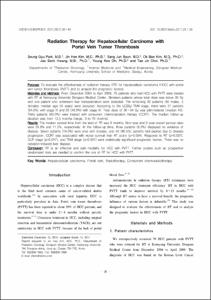KUMEL Repository
1. Journal Papers (연구논문)
1. School of Medicine (의과대학)
Dept. of Radiation Oncology (방사선종양학)
Radiation Therapy for Hepatocellular Carcinoma with Portal Vein Tumor Thrombosis
- Keimyung Author(s)
- Kim, Jin Hee; Kim, Ok Bae; Oh, Young Kee; Hwang, Jae Seok; Choi, Tae Jin
- Department
- Dept. of Radiation Oncology (방사선종양학)
Dept. of Internal Medicine (내과학)
Dept. of Medical Biophysics Engineering (의공학과)
- Journal Title
- Radiation Oncology Journal
- Issued Date
- 2011
- Volume
- 29
- Issue
- 1
- Abstract
- 목적: 간문맥종양혈전증을 동반한 간세포암에서 방사선 치료의 효과와 이에 영향을 미치는 인자들에 대해 알아보기 위하여 연구를 계획하였다.
대상 및 방법: 2004년 12월부터 2009년 4월까지 계명대학교 동산의료원 방사선종양학과에서 간세포종양에 의한 간문맥 혈전부위에 방사선 치료를 받은 환자는 70명이었고 그 중 30 Gy 미만의 방사선 조사를 받은 19명의 환자와 간이식을 시행한 1명의 환자를 제외한 50명의 환자를 대상으로 하였다. 성별 구성은 남성이 45명, 여성이 5명이었고, 연령분포는 32세에서 79세(중앙값, 55세)이었다. 39명의 환자가 방사선 치료 전 간동맥 화학 색전술, 경피적 에탄올 주입술 등의 시술을 받았다. TNM 병기에 따른 분류는 III기 27명(54.0%), IV기 23명(46.0%)이었다. 방사선 치료는 총 조사선량 30∼54 Gy (중앙값, 45)의 외부방사선을 조사하였으며, 이 중 동시항암화학방사선 치료를 받은 환자는 30명(60.0%)이었다. 추적관찰기간은 3개월에서 70개월(중앙값, 13.5)이었다.
결과: 방사선치료 시작부터 전체 환자의 중앙생존기간은 9개월이었고, 1년 생존률은 24.9%, 2년 생존률은 11.2%이었다. 현재 무병생존은 3명(6.0%), 유병생존은 7명(14.0%), 질병악화로 인한 사망은 40명(80.0%)이었다. 생존율에 영향을 미치는 인자에 대한 단변량분석 상, 동시항암화학방사선 치료는 방사선치료 단독치료보다 낮은 생존율을 보였다(p=0.034). 방사선치료에 대한 종양의 반응(p=0.037), CLIP 병기(p=0.017), TNM 병기(p=0.041)가 통계적으로 유의한 결과를 보였다. 방사선에 의한 간독성은 관찰되지 않았다.
결론: 간문맥종양혈전을 동반한 간세포암에서 방사선치료는 안전하게 생존율의 향상을 얻을 수 있는 방법으로 생각된다. 향후 간문맥종양혈전을 동반한 간세포암에서 방사선치료의 역할을 알아보기 위한 무작위 전향적 임상연구가 필요하리라 생각된다.
핵심용어: 간세포암, 간문맥, 방사선치료, 동시항암화학방사선치료
Purpose: To evaluate the effectiveness of radiation therapy (RT) for hepatocellular carcinoma (HCC) with portal vein tumor thrombosis (PVTT) and to analyze the prognostic factors.
Materials and Methods: From December 2004 to April 2009, 70 patients who had HCC with PVTT were treated with RT at Keimyung University Dongsan Medical Center. Nineteen patients whose total dose was below 30 Gy and one patient who underwent liver transplantation were excluded. The remaining 50 patients (45 males, 5 females; median age 55 years) were analyzed. According to the LCSGJ TNM stage, there were 27 patients (54.0%) with stage III and 23 (46.0%) with stage IV. Total dose of 30∼54 Gy was administered (median 45).
Thirty patients (60.0%) were treated with concurrent chemoradiation therapy (CCRT). The median follow-up duration was from 13.5 months (range, 3 to 70 months).
Results: The median survival time from the start of RT was 9 months. One-year and 2-year overall survival rates were 24.9% and 11.2%, respectively. At the follow-up time, three patients (6.0%) displayed no evidence of disease. Seven patients (14.0%) were alive with disease, and 40 (80.0%) patients had expired due to disease progression. CCRT was associated with worse survival than RT alone (p=0.034). Response to RT (p=0.037), CLIP stage (p=0.017), and TNM stage (p=0.041) were statistically significant prognostic factors. There was no radiation-induced liver disease.
Conclusion: RT is an effective and safe modality for HCC with PVTT. Further studies such as prospective randomized trials are needed to confirm the role of RT for HCC with PVTT.
Key Words: Hepatocellular carcinoma, Portal vein, Radiotherapy, Concurrent chemoradiotherapy
- Alternative Title
- 간문맥종양혈전증을 동반한 간세포암에서의 방사선 치료
- Publisher
- School of Medicine
- Citation
- Seung Gyu Park et al. (2011). Radiation Therapy for Hepatocellular Carcinoma with Portal Vein Tumor Thrombosis. Radiation Oncology Journal, 29(1), 36–43. doi: 10.3857/jkstro.2011.29.1.36
- Type
- Article
- ISSN
- 2234-1900
- 파일 목록
-
-
Download
 oak-bbb-1050.pdf
기타 데이터 / 285.7 kB / Adobe PDF
oak-bbb-1050.pdf
기타 데이터 / 285.7 kB / Adobe PDF
-
Items in Repository are protected by copyright, with all rights reserved, unless otherwise indicated.